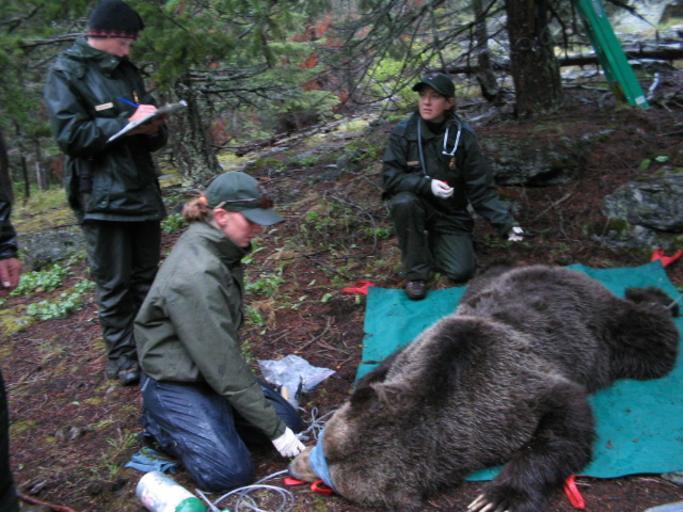MAKE A MEME
View Large Image

| View Original: | Tranquilized_grizzly_being_measured_and_monitored_(Northern_Divide_Grizzly_Bear_Project).jpg (640x480) | |||
| Download: | Original | Medium | Small | Thumb |
| Courtesy of: | www.flickr.com | More Like This | ||
| Keywords: bear grizzly grizzly bear grizzlybear usgs science research glacier national park glaciernationalpark national park nationalpark nps national park service nationalparkservice outdoor A tranquilized grizzly bear is monitored closely by field biologists while measurements are taken and a radio collar is attached. Radio collars are invaluable tools which allow bear researchers and managers to gather survival and reproductive data on individual bears. Once enough data, approximately 100 "bear years", is accumulated it becomes possible to mathematically estimate trends in the grizzly population. A "bear year" is gathered through monitoring a single bear over the course of one year. Thus, a sample of 25 collared bears tracked for 4 years would yield 100 bear years of data. Managers of the Northern Continental Divide Ecosystem (of which Glacier National Park is a part) are striving to keep 25 bears (primarily females with cubs) radio collared with state-of-the-art GPS/ARGOS collars. These collars locate themselves through the Global Positioning Satellite (GPS) system and then transmit their location to researchers through the ARGOS satellite system. This provides bear researchers and managers with invaluable data, including near real-time location information about individual bears. www.nrmsc.usgs.gov/research/NGSbear_monitoring.htm www.nps.gov/glac/naturescience/bears.htm A tranquilized grizzly bear is monitored closely by field biologists while measurements are taken and a radio collar is attached. Radio collars are invaluable tools which allow bear researchers and managers to gather survival and reproductive data on individual bears. Once enough data, approximately 100 "bear years", is accumulated it becomes possible to mathematically estimate trends in the grizzly population. A "bear year" is gathered through monitoring a single bear over the course of one year. Thus, a sample of 25 collared bears tracked for 4 years would yield 100 bear years of data. Managers of the Northern Continental Divide Ecosystem (of which Glacier National Park is a part) are striving to keep 25 bears (primarily females with cubs) radio collared with state-of-the-art GPS/ARGOS collars. These collars locate themselves through the Global Positioning Satellite (GPS) system and then transmit their location to researchers through the ARGOS satellite system. This provides bear researchers and managers with invaluable data, including near real-time location information about individual bears. www.nrmsc.usgs.gov/research/NGSbear_monitoring.htm www.nps.gov/glac/naturescience/bears.htm | ||||